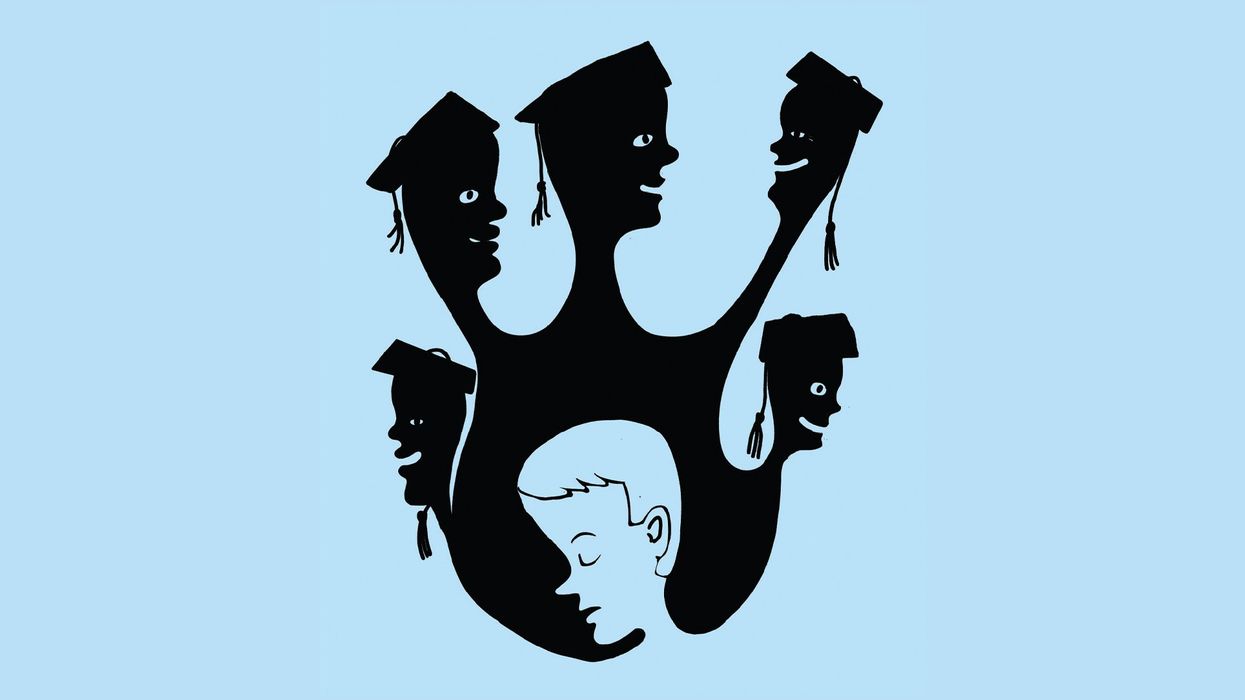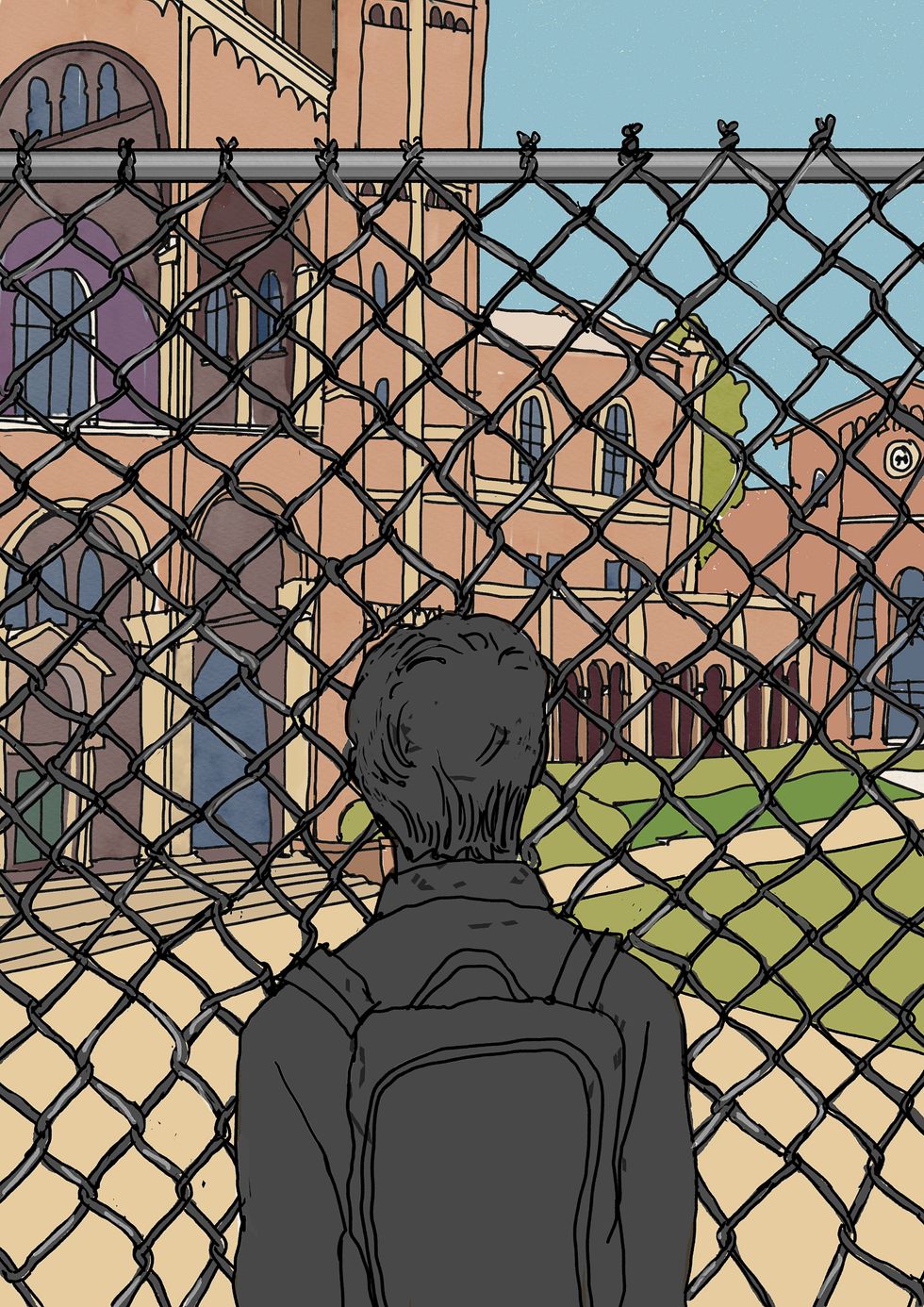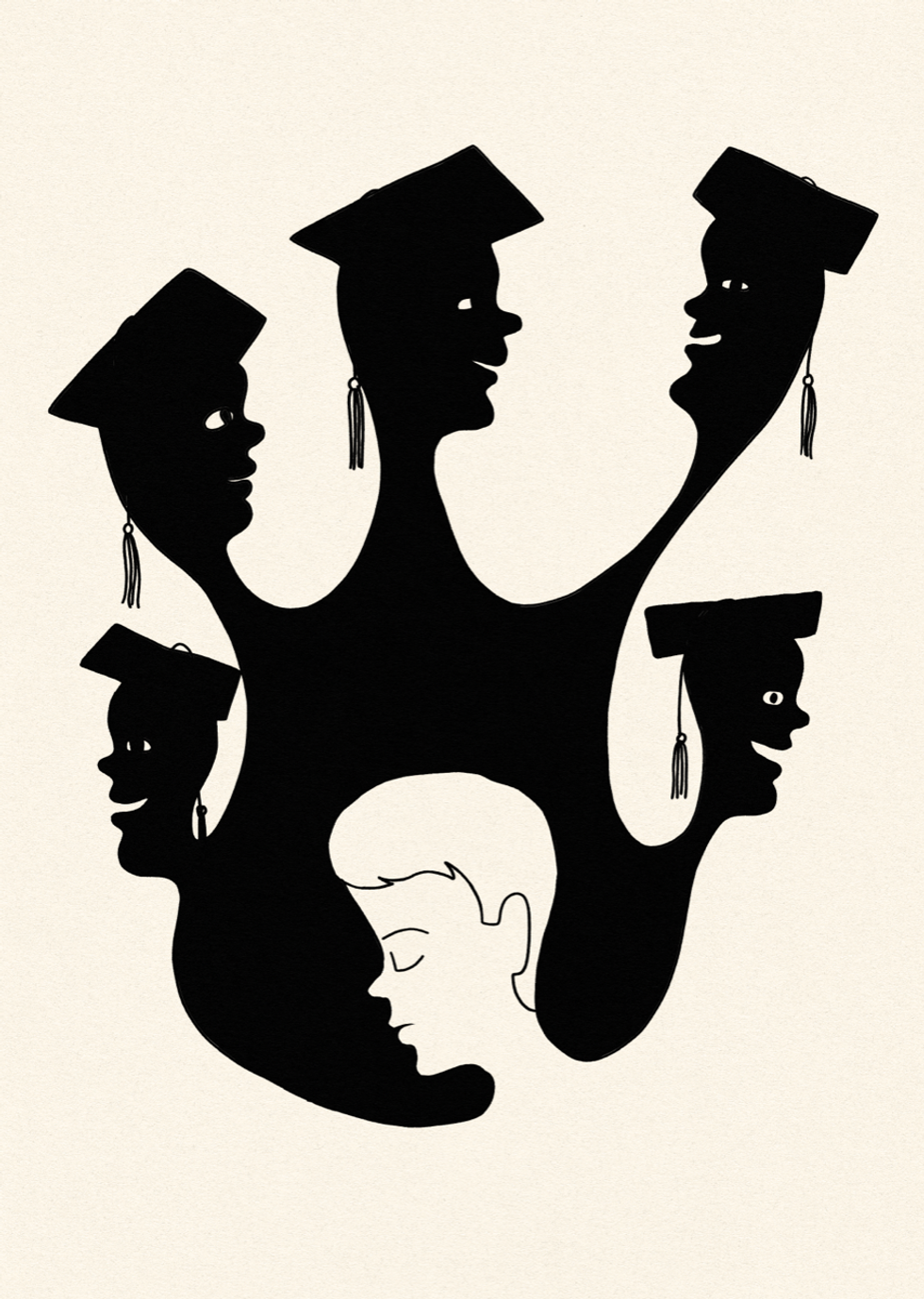
Illustration by Gabriel Gigliotti

The Golden State’s inadmissible star students battle racial discrimination in a state on the brink.
My first two children arrived just fifteen months apart. I didn’t realize it at the time, but this meant I would have back-to-back college seniors. I hadn’t paid much attention to America’s rolling higher education debacle. But two years ago, we were conscripted into a grueling college admissions journey—a seemingly endless gauntlet of AP tests, SATs, college applications, Common Apps, essays, and transcripts. And then the panic.
Yes, panic—the kind filled with tears, disbelief, and heartbreak. As my kids grew up, I eagerly anticipated a smooth, uninterrupted path into an elite college for both of them. They were so bright, so precocious, and scored high on IQ tests. Nothing would stop them from taking their rightful place in the elite college of my maternal dreams.
The UCs are effectively using their freshman dorms as refugee centers for kids who have been sponging off California citizens for their entire lives, and as a final F-you, the schools gleefully hand your kid’s spot to the Sacred Undocumented Dreamer.
But this was in the “Before Times,” before I became fully aware of the strict race and gender quotas jealously guarding the entrance to these formerly prestigious academic institutions. Before intersectional identities, racial reckonings, LGBTQ activists, and BLM had fully rampaged through the admissions offices. Before I started hearing the horror stories of overqualified high school seniors being blocked from admission at schools that they would almost certainly have gotten into, say, 10 years ago.
Now the beneficiary of at least some hard-won knowledge, I can report that things are… dire. More so than you dare imagine.
California has always been the American frontier—literally and spiritually. It was the terminus of all western overland journeys, the place Americans old and young dreamed of going one day. Newspaper editor Horace Greeley exhorted them to go for it in 1865 in his famous statement in the New York Daily Tribune: “Washington is not a place to live in. The rents are high, the food is bad, the dust is disgusting and the morals are deplorable. Go West, young man, go West and grow up with the country.”
And go they did. By the millions. Many only stopping when they could go no further, including my own East Coast ancestors and my husband’s Gold Rush-era forebears.
Today, the California frontier is no longer Manifest Destiny’s last stop but the bleak terminal where the American dream has curled up in the sunshine and died. At last, the accumulated indignations and tortures of the past few decades are reaching critical mass. Longtime Californians who doggedly stayed for the last 30 years are now peeling off in large numbers. This is remarkable, since these are the diehards.
The people still here are California enjoyers who stuck it out through a never-ending storm battering their patience. They hung on as wave after wave of dystopian socialism masquerading as progress, mass immigration, and Democrat city wreckers smashed into their suburban ranch homes. They stayed through the closure of aerospace industry firms that essentially built the 20th-century middle class around Los Angeles. They didn’t budge as Hollywood productions decamped for cheaper states. They survived race riots, earthquakes, fires, worsening traffic and crime, the sanctuary state deluge, the ruin of their formerly great public schools, the COVID cataclysm, and even more fires this past January.
It’s a tragedy that college admissions have become a ridiculous forensic examination of a child’s particular ethnic or racial background.
Why did they stay? For many families, there was only one good reason left: to take advantage of the last great perk to living in California: low in-state tuition to some of the best universities in the country. UCLA, UC Berkeley, UC San Diego, and UC Irvine can be your child’s new school for the bargain price of around $14,000 a year in tuition (not including room and board).
This year, UCLA’s tuition will be $14,900, remarkably low compared to other colleges. In 2020, it was $13,200. In 1980, UCLA tuition was around $3,000, but compared to the prices of housing and everything else, it has stayed relatively affordable. It’s a price that makes the pain of life here, and property taxes, and state income taxes, easier to bear.
But there’s an important caveat: first, your kids have to get in. That should be no problem; after all, this school system was built for California’s kids.
Sadly, this is no longer true.
Every year, the citizens of California realize they have been scammed as their kids face college denial after college denial, forcing them to send their children out of state, where tuition costs four or even five times more. UCLA, which I considered a safety school in the 1990s, had an admission rate of 40% when I was in high school.
This spring, the freshman admission rate was 8.6%.
If you want a picture of the Great Replacement, just look at California’s changing demographics. The formerly bright red state was 70% white in 1990 and 25% Hispanic. As of 2024, California is 34% white. To take UCLA as an example, it closely resembles the state’s demographics: 35% Asian, 22% Hispanic, 25% white, and 6.5% African American. Twenty-nine percent are first-generation undergraduate students, and almost 8% are international students.
The most shocking statistic of all, however, is the gender gap: just 38.2% of UCLA undergrads are male. (And that number includes all the biological girls who think they’re boys.)
Most painful is the official UC campaign to increase “diversity” at the expense of “non-diverse” (i.e., white and Asian) students who may be more qualified or have higher test scores. Even though affirmative action was legally banned from the college admissions offices, we all know it’s in effect.
The increase in black and Latino enrollment reflects UCLA’s race-neutral recruitment, including partnerships with LA Unified high schools and community organizations, as noted by Associate Vice Chancellor Gary Clark. The decline in White students (8.8%) and stable Native American numbers align with UCLA’s focus on underrepresented groups.
When they tell you you are being replaced, believe them. “Research suggests the percentage of white native-born American citizen males in UCLA’s Fall 2024 freshman class is around 8.8%.” This means that a white male has to make the first 8% cut just to get in, and then they’re only going to be 8% of that final number.
Los Angeles County, of course, already enjoys tremendous diversity: it’s only 15% Caucasian—which, to liberals, means there’s only 15% more to go.

If you grew up here, the change has been swift and startling. You may not realize it when you’re hanging out at the Brentwood Country Mart with locals like Doug Emhoff and Gwyneth Paltrow, but go visit the Santa Monica Pier during the summer. At any Costco in the San Gabriel Valley, Mandarin is the local language, and English is a foreign tongue.
I recently spent some time in Tennessee, just south of Nashville. It was jarring to see legions of families I recognized from my childhood. “Oh, here are all the Californians I used to see all the time!” I thought. And in fact, most of my California friends who have moved to Tennessee report that, yes, half their neighbors are former Californians who wisely fled the madness.
With all the numbers fleeing California, why is admission to a UC school and access to the best tuition bargain in the country so tough? Only one boy at our school got into UCLA last year. This year, only one got into Berkeley.
Is it because there are more high school seniors than ever in 2025? Maybe.
But most people point to the stringent DEI filters in the admissions offices. The rare white male who is admitted now is either a superdonor’s nepo baby, a super athlete, or a super-elite scholar. High-achieving middle-class kids, the bread and butter of the UC system, are shunted to lower-tier schools like UC Merced or UC Riverside. UC Irvine, the fourth-best UC, is 34% Asian, 24.1% Hispanic, 15% white, and 2.23% black.
It’s a tragedy that college admissions have become a ridiculous forensic examination of a child’s particular ethnic or racial background. It’s more than a tragedy; it’s an abomination. But race-based admissions are ingrained too deeply in the core of these schools. Yes, affirmative action is technically illegal at the UCs, but it is not exactly rocket science to figure out the ethnic and economic background of Tariq from Inglewood, Maria Ruiz from Boyle Heights, or Gabe Kaplan from Brentwood. In fact, my son had to submit a video of himself to Berkeley as part of his application (he was rejected eventually).
Meanwhile, some Bay Area high schools send huge numbers of students to Berkeley, the jewel of the UC system. Why?
Because they are filled with undocumented students and—incredibly—embedded UC admissions officers, who literally work at these high schools to give students a boost. The University of California’s Early Academic Outreach Program places admissions officers at underserved high schools to do whatever it takes to help otherwise unprepared students make the cut. “UCLA, like other University of California campuses, provides direct college counselors—sometimes embedded at the high schools—to supplement the school’s own staff.” They describe the program this way:
EAOP advisers and volunteers help students complete college applications and write effective personal statements. Intensive workshops and summer programs help students improve academic skills so they perform better in their A-G classes. EAOP helps families complete the Free Application for Federal Student Aid (FAFSA) and the California Dream Act application, and apply for grants and scholarships. EAOP advisers help each student prepare an individual plan detailing the A-G classes to take—and when to take them—to prepare for UC.
I can’t help but notice that not a single EAOP advisor has ever set foot at my children’s school, despite the fact that the parents at my school pay all the UC employee salaries with our taxes. I wonder why that is.
For a UC campus, however, the payoff is huge. Filling a freshman class with the undocumented children of illegal immigrants is a huge flex—and a middle finger to the Trump administration. The more, the better. Administrators can brag in their marketing materials that their campus is a safe space for people ICE would like to deport.
The UCs are effectively using their freshman dorms as refugee centers for kids who have been sponging off California citizens for their entire lives, and as a final F-you, the schools gleefully hand your kid’s spot to the Sacred Undocumented Dreamer who didn’t even bother to take the SAT.
There is one more reason why California universities are suddenly out of reach for vast swaths of kids who, in any other era, would be assured admission: the F-1 student visa. The F-1 visa admits, in other words, the international students are even more important to the universities than the undocumented students. They are a prized resource, a cash cow, and given first dibs for spots in every freshman incoming class.
An F-1 visa is “a non-immigrant visa issued by the United States to international students who wish to pursue academic studies or language training programs at an accredited US college, university, seminary, conservatory, academic high school, elementary school, or other academic institution.” To secure a visa, you have to show an “intent to return” to your country after completing your studies—unless you get a STEM job, in which case you can stay three more years.
According to the Institute of International Education, 1,058,477 international students enrolled in US higher education institutions during the 2023–2024 academic year. The total number of F-1 visa holders, including the ones here post-graduation, is 1.2–1.35 million. At UCLA, 8% of undergrads are international, and a whopping 17% of graduate students are international.
But forget the “diversity” issue. Almost 8% of undergraduate spots go to international students who pay full out-of-state tuition, which is over $50,000 a year, not including room and board. Now follow the money: the UC system has 20,000 foreign students on F1 visas, and that’s just the undergrads. There are many more foreign grad students, raking in an estimated $1 billion a year in tuition from international kids.
One could argue that these foreign students are essentially being allowed to rob California teens of the state-run institutions originally built “for them.” And the state is fully complicit in the theft.

When I applied to college a thousand years ago, I aimed high. My goal was to “go to the best college” I got into. The field was wide open for me. I went to a good high school, had around a 3.7 GPA, and good SATs. Tuition, room, and board, even at elite private colleges, totaled under $20,000. Go to an even cheaper state school like UCLA or Berkeley? Please.
At my alma mater, a prestigious Ivy League university, the acceptance rate hovered between 30% and 40%. Now it’s around 4%. Literally zero of my college friends would have gotten accepted if they’d applied this year—I didn’t hang out with the nerds.
My oldest had a 4.2 GPA and 1450 SAT, did lots of activities, was a record-holding powerlifter, and an all-around great kid. He was denied from the UCs and USC. I kept begging him to check the “transgender” box on the applications and wear a little eyeliner and an earring in the video he had to send to Berkeley. But to his credit, he refused.
It was an eye-opening experience. Twenty years ago, UCLA would have been his safety school. Now, with an 8% acceptance rate, it is what Harvard or MIT was for my generation. Almost impossible to fathom. UCLA? I mean, it is an excellent school, but it’s so big, so massive, and seemingly built to accept smart California kids. How is it possible that kids like mine were no longer welcome at Hamas U? Is it because he was part Jewish?
Happily, my oldest ended up at a much better school than communist Berkeley and is loving his life off at college.
My next oldest is a science guy. He had higher test scores than his older brother and slightly more uneven grades. After the first kid’s experience, we totally shunned the UCs and didn’t waste any money on the $80 (!) per campus application fee. We aimed for programs at various mid-tier schools across the country that had the major he wanted. He was rejected from some of his favorites and accepted by a few others.
He just committed to one of the colleges that accepted him, and I have extremely mixed feelings about it. He will be attending a California university that is decent, fine, pretty good even. It has the majors he’s interested in and will be a safe and, God willing, productive place for him to spend four years. Meanwhile, 15% of the undergraduates are non-Hispanic white, which means the university has almost completed the diversification process. Only 15% more to go until they achieve “total diversity.”
In other words, he will not just be studying science—he will experience America’s post-replacement future on the frontlines. And he’ll experience it where it’s happening first, as important things always do: California. l
Peachy Keenan is a writer and mother of five in Los Angeles. Her bylines have appeared in The American Mind, The Federalist, Blaze Media, and more. Her first book Domestic Extremist: A Practical Guide to Winning the Culture War was published in 2023, and she has two new books coming soon from Passage Press.com and on X.
Peachy Keenan